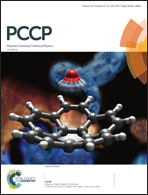Free energy profiles for two ubiquitous damaging agents: methylation and hydroxylation of guanine in B-DNA†
Abstract
DNA methylation and hydroxylation are two ubiquitous reactions in DNA damage induction, yet insights are scarce concerning the free energy of activation within B-DNA. We resort to multiscale simulations to investigate the attack of a hydroxyl radical and of the primary diazonium onto a guanine embedded in a solvated dodecamer. Reaction free energy profiles characterize two strongly exergonic processes, yet allow unprecedented quantification of the barrier towards this damage reaction, not higher than 6 kcal mol−1 and sometimes inexistent, and of the exergonicities. In the case of the [G(C8)-OH]˙ intermediate, we challenge the functional dependence of such simulations: recently-proposed functionals, such as M06-2X and LC-BLYP, agree on a ∼4 kcal mol−1 barrier, whereas the hybrid GGA B3LYP functional predicts a barrier-less pathway. In the long term, multiscale approaches can help build up a unified panorama of DNA lesion induction. These results stress the importance of DFT/MM-MD simulations involving new functionals towards the sound modelling of biomolecule damage even in the ground state.



 Please wait while we load your content...
Please wait while we load your content...